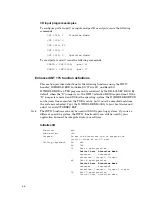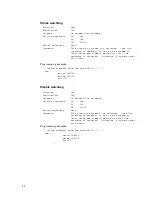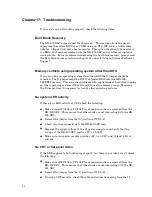
Chapter 13: USB
Description
Universal Serial Bus (USB) is a hardware interface for peripherals such as the
keyboard, mouse, joystick, scanner, printer, and telephony devices. USB 2.0 has a
maximum trasnfer rate of 480 Mbits/sec; USB 1.1 has a maximum transfer rate of
12 Mbits/sec. Peripherals can be plugged in and unplugged while power is applied
to the system (see Caution below). Up to 127 devices can be attached. The XE–800
SBC contains four USB 2.0 compliant ports and two USB 1.1 compliant ports.
The 2.0 compliant ports are accessed via standard USB connectors at J12 (USB 3
and 4) and J13 (USB 5 and 6). The 1.1 compliant ports are accessed via a 10-pin,
0.1” pitch connector at J16 (USB 1 and 2).
Octagon provides a cable that routes the J16 signals to standard USB connectors
(Octagon p/n 6288). This cable consists of two five-pin connectors that mate with
the J16 connector on one end, and two USB connectors at the other end. Ensure
that the arrow on the five-pin connectors is matched to the pin 1 end of J16. Any
USB device can then plug into either USB interface on the USB adapter cable, or
into a multi-port hub that then plugs into the USB adapter cable.
An operating system capable of utilizing the USB ports and USB devices is
required for USB operation.
Caution
USB devices are hot-swappable when a device is plugged into a
standard USB connector (J12 and J13), as pins on the connectors
determine the order in which they make contact. Devices are not
hot-swappable when connected to a non-standard header (J16). You
can hot swap a device through the USB Adapter cable connected to
J16, or through another USB connector wired to the 10-pin header,
but you cannot hot swap at the 10-pin header itself.
76
















































